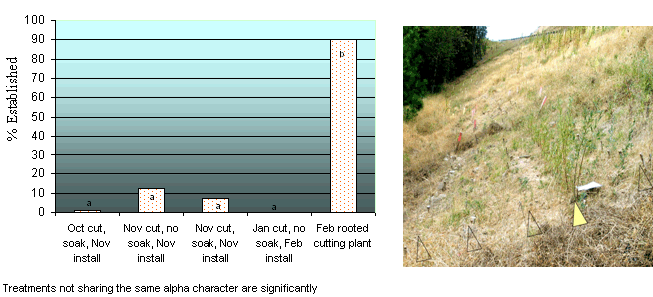ROADSIDE REVEGETATION
An Integrated Approach to Establishing Native Plants and Pollinator Habitat
Learn
Slope Pinning with Willow Stakes
| Location: | Tiller Trail Highway (Highway 227) 5 miles south of Tiller OR |
| Lat/Long: | N42o56’35.7”, W123o00’53.1” |
| Dates Implemented: | Fall 2004, Winter 2005 |
| Client: | Western Federal Lands Highway Division |
| Planners: | R6 Restoration Services Team |
| Contractors: | Follow the Sun, Stone Nursery, Tiller Ranger District, Flathead Construction |
| Case Number: | 0003 |
| Date Submitted: | December 2008 |
| Focus Area: | Biotechnical Engineering, Cuttings |
Background and Objectives
During the winter of 2003/2004 a large, recently constructed fillslope (2:1 slope, south aspect) developed shallow slope failures. To increase stability, a plan to pin the slope with live willow stakes the following fall (2004) was developed. Because of the high quantity of stakes that needed to be cut and due to the construction schedule that required the road contractor to finish work before winter, stakes had to be cut in October and stored until installation in November. There were concerns that the willows would still be physiologically active in October when harvesting would take place, resulting in stakes with low viability (low potential to root the following spring). Since other highway projects called for willow cuttings being collected outside the dormant period, an administrative trial was installed to assess the effects of these practices on the establishment of willows plants from live stakes. The trial evaluated the effects of cutting willows in October, November, and January and soaking willow stakes in water1; and compared these treatments to using rooted cuttings (cuttings rooted in containers and grown for a season in a nursery).
Implementation
Slope Pinning: 3450 live willow stakes were cut from stands of willow (Salix scouleriana) near the project site during October 2004. The stakes were bundled and submerged in water for several weeks, then in November they were installed on the fill slopes at 3 foot centers. Stakes were installed by the road contractor using a metal rod (a "stinger") welded to the bucket of an excavator to create the hole. A live stake was placed in the hole and pushed into the soil using the bucket face of the excavator. At the same time, modified branch layers were installed in different areas of the fill slope.
Administrative Trial: Five treatments were installed on the same site as the slope pinning project. The treatments consisted of: 1) Oct cut, soak, install late Nov, 2) Nov cut, no soak, install late Nov, 3) Nov cut, soak, install late Nov, 4) Jan cut, no soak, install Feb, 5) install rooted cuttings in Feb. The trial consisted of 8 replications of 5 treatments, each treatment consisting of 10 cuttings or rooted cuttings.
Findings
Slope Pinning: Live stakes established poorly and by the end of the first summer approximately 10 percent of the stakes had become established. These findings corresponded well to the results of the administrative trial. Since there were no DFC's, or success criteria, defined for this project, it is not known whether this was a successful project or not (even though there was only 10% survival, there were still at least 300 willow plants that had become established). The live brush layers, on the other hand, established quite well, supporting the premise that younger willow branches are generally more viable than older, larger willow stems.
Administrative Trial: Data collected on May 23, 2005 after a moist spring (ideal for establishing roots on willow stakes) indicated that of the five treatments, the treatment where willows were cut in October, soaked in water, and installed in November performed the worst (10% alive). Forty to sixty percent of the November and January harvested willows were alive compared to 100% of the rooted cutting, however survival measurements (see graph) taken after a hot, dry summer, three months later, showed that only the rooted cuttings had successfully established (90% survival), whereas willow stakes from the other four treatments had minimal establishment (<15%).
Figures
The graph shows the percent of cuttings or rooted cuttings that became established plants by the end of the first summer. The only successful treatments were the rooted cuttings planted in February. The photograph on the right was taken of one of the 8 blocks in May, several months after installation. The tall plants (yellow triangle) are the rooted cutting treatment and the open triangles are the stakes from the other treatments.

Applicability
The findings from this project point to an approach that can be applied to most projects calling for the installation of live willow stakes. Two questions should be asked when using live willow stakes.. First, are the cuttings viable at harvest (are they dormant, healthy, of the appropriate size, dimension, age etc) and second are they being installed on sites where they can establish into healthy plants (are the summers mild, is there ground water near the surface etc). The answer must be yes to both questions to achieve successful establishment. In this trial the May survey showed that there was fair to moderate viability of the willow stakes collected in November and January. Nevertheless these plants could not survive the harsh conditions of this site (south aspect, poor soils, dry summers) after the first summer . An alternative to installing live stakes is to use rooted cuttings produced from a nursery. While these plant materials are more expensive, they assure greater establishment of plants.
Related Links
Evaluation of Willow Propagation Methods FHWA Canyonville 5 Project (320 KB PDF)
Contact Information
David Steinfeld, USDA Forest Service; 541-552-2912, dsteinfeld@fs.fed.us
1 A practice shown to be effective for spring installed willow cuttings.